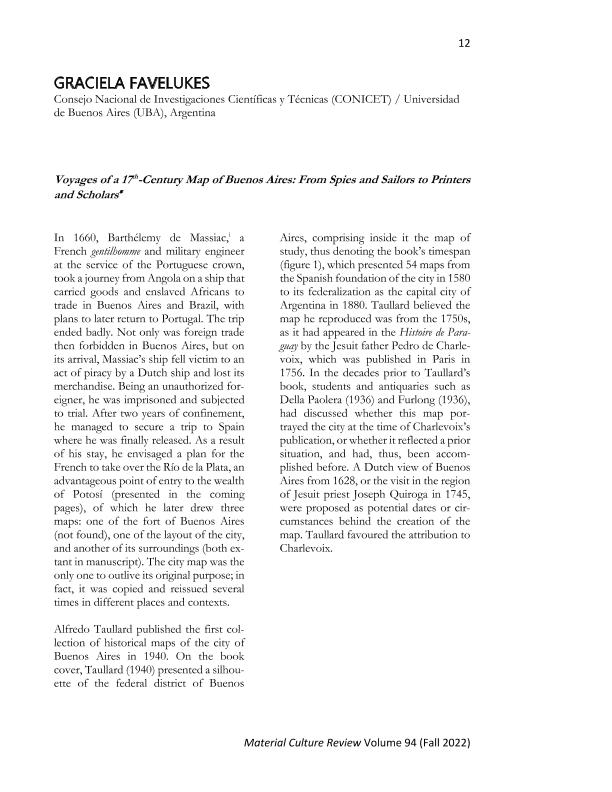Mostrar el registro sencillo del ítem
dc.contributor.author
Favelukes, Graciela Noemí

dc.date.available
2023-10-20T14:13:10Z
dc.date.issued
2022-09
dc.identifier.citation
Favelukes, Graciela Noemí; Voyages of a 17th-Century Map of Buenos Aires: From Spies and Sailors to Printers and Scholars; Mount Allison University; Material Culture Review; 94; 9-2022; 12-32
dc.identifier.issn
1927-9264
dc.identifier.uri
http://hdl.handle.net/11336/215540
dc.description.abstract
The proposed paper will present the long and rich life span of a city map of Buenos Aires and its changing settings, by following the many editions of a map first drawn by a French military engineer, Barthelemy de Massiac, that stayed as a prisoner in the city between 1660 and 1662. This example helps to further questions referring to the problem of stability / instability of maps. How do copies and adaptation to different supports or media affect their alleged unicity? How do they travel and what are the effects of their journeys? The problem may be addressed on the basis of the works on sociology of culture and science by Pierre Bourdieu, and on the history of the book and print culture by Roger Chartier. Although they don´t specifically study maps, their views add to the social and cultural approach to maps of the now classical critical studies in history of cartography by John B. Harley and David Woodward, among others. In this respect, Bourdieu stressed that ideas, books especially (as well as, it can be added, images and maps), travel without their context of production, through appropriations, translations and editions that sustain their circulation in space and, I also add, in time. The work of Roger Chartier also offers ground for this claim, as do his more recent work about images and their life in manuscripts, print and digital records and production. On a more epistemological perspective, attention to these changing supports, media and audiences contributes to rethink Bruno Latour’s definition of maps as immutable mobiles that sustained the making of modern science. I intend to address these issues presenting an example of the many copies, versions, printing of a map and its consequent storing, selling, circulating, archiving and studying, that show both the persistence and mutability of maps in shifting scenarios and readership. Briefly, the map drawn in 1669 by de Massiac lived a broad and long life, travelling from drawing desk to shelves, from print to books, from geography to antiquarianism and tourism, from urbanism to history, along at least 15 different versions and supports made until 1981, always surrounded by doubts about its trustworthiness yet at the same time used as a virtual logotype for the earlier stages of the city of which no other plans survive. Much later, pursue in French archives helped restore its original status as part of a military plan. The significance of recovering its original condition is more fully grasped when we put it into the perspective of its changing appropriations and journeys in time, place and varying scholarship.
dc.format
application/pdf
dc.language.iso
eng
dc.publisher
Mount Allison University
dc.rights
info:eu-repo/semantics/openAccess
dc.rights.uri
https://creativecommons.org/licenses/by-nc-sa/2.5/ar/
dc.subject
HISTORY OF CARTOGRAPHY
dc.subject
BUENOS AIRES
dc.subject
MATERIAL CULTURE
dc.subject
PRINT
dc.subject.classification
Otras Historia y Arqueología

dc.subject.classification
Historia y Arqueología

dc.subject.classification
HUMANIDADES

dc.subject.classification
Otras Humanidades

dc.subject.classification
Otras Humanidades

dc.subject.classification
HUMANIDADES

dc.title
Voyages of a 17th-Century Map of Buenos Aires: From Spies and Sailors to Printers and Scholars
dc.type
info:eu-repo/semantics/article
dc.type
info:ar-repo/semantics/artículo
dc.type
info:eu-repo/semantics/publishedVersion
dc.date.updated
2023-10-19T14:34:37Z
dc.journal.volume
94
dc.journal.pagination
12-32
dc.journal.pais
Canadá

dc.journal.ciudad
Sackville
dc.description.fil
Fil: Favelukes, Graciela Noemí. Consejo Nacional de Investigaciones Científicas y Técnicas; Argentina
dc.journal.title
Material Culture Review
dc.relation.alternativeid
info:eu-repo/semantics/altIdentifier/url/https://journals.lib.unb.ca/index.php/MCR/article/view/32834
Archivos asociados
